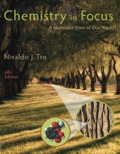
Interpretation:
Some common processes that involve redox reactions are to be listed.
Concept Introduction:
Oxidation is the addition of an electronegative element or the removal of an electropositive element in the
Reduction is the addition of an electropositive element or the removal of an electronegative element in the chemical reaction.
The chemical reaction in which oxidation and reduction takes place simultaneously is called a
An oxidizing agent is a substance that has the capacity to oxidize the other substances and get reduced in a chemical reaction.
A reducing agent is a substance that has the capacity to reduce the other substances and get oxidized in a chemical reaction.
Answer to Problem 3E
Solution:
Some common examples that involve redox reactions are:
Burning of coal,
Respiration,
Photosynthesis and
Rusting of iron
Explanation of Solution
The chemical equation for the respiration reaction is as follows:
An oxidizing agent gains electrons easily and a reducing agent loses electrons easily in a chemical reaction.
In this chemical reaction, the oxidation state of
In this chemical reaction, the oxidation state of
The chemical equation for the photosynthesis reaction is as follows:
An oxidizing agent gains electrons easily and a reducing agent loses electrons easily in a chemical reaction.
In this chemical reaction, the oxidation state of
In this chemical reaction, the oxidation state of
The chemical equation for the burning of coal is as follows:
An oxidizing agent gains electrons easily and a reducing agent loses electrons easily in a chemical reaction.
In this chemical reaction, the oxidation state of
In this chemical reaction, the oxidation state of
The chemical equation for the rusting of iron is as follows:
Oxidation is the loss of electrons or gain of oxygen in a chemical reaction. Reduction is the gain of electrons or loss of oxygen in the chemical reaction.
In this chemical reaction, the oxidation state of
In this chemical reaction, the oxidation state of
Some common processes which involve redox reactions are rusting of iron and photosynthesis reaction.
Want to see more full solutions like this?
Chapter 14 Solutions
Chemistry In Focus
- Indicate the differences between the spectra of 1-methyl-benzimidazole and benzimidazole.arrow_forwardProvide reasons as to why appropriate sampling is important in relation to food?arrow_forwardWhat is the significance of selecting a "representative" sample for chemical analysis, and how does this practice ensure accurate and reliable results with respect to chemical analyses?arrow_forward
- Identify and provide an explanation of the differences between homogeneous and heterogeneous sampling in the context of sampling methods.arrow_forwardГ C-RSA CHROMATOPAC CH=1 DATA 1: @CHRM1.C00 ATTEN=10 SPEED= 10.0 0.0 b.092 0.797 1.088 1.813 C-RSA CHROMATOPAC CH=1 Report No. =13 ** CALCULATION REPORT ** DATA=1: @CHRM1.000 11/03/05 08:09:52 CH PKNO TIME 1 2 0.797 3 1.088 4 1.813 AREA 1508566 4625442 2180060 HEIGHT 207739 701206 V 287554 V MK IDNO CONC NAME 18.1447 55.6339 26.2213 TOTAL 8314067 1196500 100 C-R8A CHROMATOPAC CH=1 DATA 1: @CHRM1.C00 ATTEN=10 SPEED= 10.0 0. 0 087 337. 0.841 1.150 C-R8A CHROMATOPAC CH=1 Report No. =14 DATA=1: @CHRM1.000 11/03/05 08:12:40 ** CALCULATION REPORT ** CH PKNO TIME AREA 1 3 0.841 1099933 41.15 4039778 HEIGHT MK IDNO 170372 649997¯¯¯ CONC NAME 21.4007 78.5993 TOTAL 5139711 820369 100 3 C-R8A CHROMATOPAC CH=1 DATA 1: @CHRM1.C00 ATTEN=10 SPEED= 10.0 0.100 0:652 5.856 3 1.165 C-RSA CHROMATOPAC CH-1 Report No. =15 DATA=1: @CHRM1.000 11/03/05 08:15:26 ** CALCULATION REPORT ** CH PKNO TIME AREA HEIGHT MK IDNO CONC NAME 1 3 3 0.856 4 1.165 TOTAL 1253386 4838738 175481 708024 V 20.5739 79.4261 6092124…arrow_forwardDraw the product of the reaction shown below. Ignore small byproducts that would evaporate please.arrow_forward
- Relative Abundance 20- Problems 501 (b) The infrared spectrum has a medium-intensity peak at about 1650 cm. There is also a C-H out-of-plane bending peak near 880 cm. 100- 80- 56 41 69 M(84) LL 15 20 25 30 35 55 60 65 70 75 80 85 90 m/zarrow_forwardPolyethylene furanoate is a polymer made from plant-based sources; it is used for packaging. Identify the monomer(s) used in the production of this polymer using a condensation process.arrow_forwardPhenol is the starting material for the synthesis of 2,3,4,5,6-pentachlorophenol, known al-ternatively as pentachlorophenol, or more simply as penta. At one time, penta was widely used as a wood preservative for decks, siding, and outdoor wood furniture. Draw the structural formula for pentachlorophenol and describe its synthesis from phenol.arrow_forward
- Chemistry: Matter and ChangeChemistryISBN:9780078746376Author:Dinah Zike, Laurel Dingrando, Nicholas Hainen, Cheryl WistromPublisher:Glencoe/McGraw-Hill School Pub Co
 Chemistry: The Molecular ScienceChemistryISBN:9781285199047Author:John W. Moore, Conrad L. StanitskiPublisher:Cengage Learning
Chemistry: The Molecular ScienceChemistryISBN:9781285199047Author:John W. Moore, Conrad L. StanitskiPublisher:Cengage Learning Living By Chemistry: First Edition TextbookChemistryISBN:9781559539418Author:Angelica StacyPublisher:MAC HIGHER
Living By Chemistry: First Edition TextbookChemistryISBN:9781559539418Author:Angelica StacyPublisher:MAC HIGHER  Chemistry: Principles and ReactionsChemistryISBN:9781305079373Author:William L. Masterton, Cecile N. HurleyPublisher:Cengage Learning
Chemistry: Principles and ReactionsChemistryISBN:9781305079373Author:William L. Masterton, Cecile N. HurleyPublisher:Cengage Learning
 World of Chemistry, 3rd editionChemistryISBN:9781133109655Author:Steven S. Zumdahl, Susan L. Zumdahl, Donald J. DeCostePublisher:Brooks / Cole / Cengage Learning
World of Chemistry, 3rd editionChemistryISBN:9781133109655Author:Steven S. Zumdahl, Susan L. Zumdahl, Donald J. DeCostePublisher:Brooks / Cole / Cengage Learning





